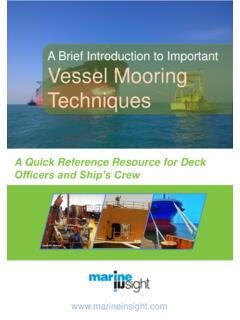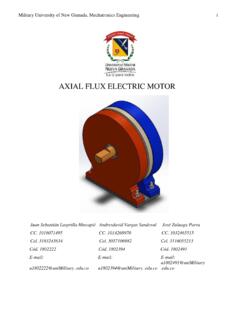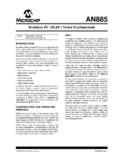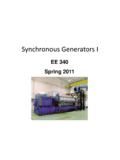Transcription of A Guide to Ship’s Electro-Technology - Marine Insight
1 A Guide to ship s Electro-Technology For Marine Engineers and Electrical Officers Part 1 2 Marine Insight A Guide to ship s Electro-Technology : Part 1 Publication date: Oct 2013 Editor: Raunek Kantharia Published by: Marine Insight Graphic Design: Anish Wankhede Copyright 2013 Marine Insight NOTICE OF RIGHTS All rights reserved. No part of this book may be rewritten, reproduced, stored in a retrieval system, transmitted or distributed in any form or means, without prior written permission of the publisher. NOTICE OF LIABILITY The authors and editors have made every effort possible to ensure the accuracy of the information provided in the book. Neither the authors and Marine Insight , nor editors or distributors, will be held liable for any damages caused either directly or indirectly by the instructions contained in this book, or the equipment, tools, or methods described herein. 3 1. Electricity on Ships - Purpose POWER GENERATION HIGH VOLTAGE SYSTEMS ELECTRICAL PROPULSION SYSTEMS 2.
2 Electrical Instruments CONSTRUCTION AND WORKING- MEGGER permanent magnet MOVING COIL (PMMC)- WORKING AND APPLICATION RECTIFIER AND RECTIFIER CIRCUITS AMPLIFIER AND AMPLIFIER CIRCUITS THERMOCOUPLES 3. Electrical Safety SAFETY DEVICES ON MAIN SWITCH BOARD ELECTRICAL SHOCK- SAFETY AND PRECAUTIONS ELECTRICAL FIRE AND INSULATION GENERATOR SAFETY BLACKOUT SITUATION 4. Electrical Maintenance EARTH FAULT ELECTRICAL RELAY MAINTENANCE ELECTRICAL MOTOR OVERHAULING ELECTRICAL STARTER PANEL ROUTINE BUSBAR MAINTENANCE ALTERNATOR MAINTENANCE CONTENT 4 POWER GENERATION ON SHIPS: A ship is equivalent to a floating city that enjoys almost all privileges available to any operational set-up on land. Just like any conventional city, the ship also requires the basic amenities to sustain life on board, the chief among them being power or electricity. Electricity on ships is generated by an alternator or generator. Shipboard power is generated when a prime mover and alternator works together.
3 For this purpose, an alternating current generator is used on board. The generator works on the principle that as a magnetic field rotating around a conductor varies, a current is induced in the conductor. The generator consists of a stationary set of conductors, wound in coils of iron core also known as the stator. A rotating magnet known as rotor turns inside this stator, producing a magnetic field, which cuts across the conductor and generates an induced EMF or electro -magnetic force as ELECTRICITY ON SHIPS A ship is an independent floating structure having its own power plant for supplying electricity to its machinery and systems, which together assist in the propulsion of the ship from one port to another. 5 the mechanical input causes the rotor to turn. The magnetic field is generated by induction (in a brushless alternator) and by a rotor winding energized by DC current through slip rings and brushes. Few points that are to be noted about power generated on board ships -AC, 3-phase power is preferred over DC as it gives more power for the same size - 3-phase is preferred over single phase as it draws more power and in the event of failure of one phase, other 2 can continue working Power Distribution on Ships: Th ship s pow distribution system consists of different components for distribution and safe operation of the system.
4 The main components of this system are: ship s generator - consists of prime mover and alternator Main switchboard - a metal enclosure taking power from the diesel generator and supplying it to different machinery systems Bus bars - acts as power carrier and allows transfer of load from one point to another Circuit breakers - act as a switch, and in unsafe conditions can be tripped to avoid breakdown and accidents Fuses - safety devices for machinery Transformers - to step up or step-down the voltage. When supply is to be given to the lighting system, a step down transformer is used in the distribution system In a power distribution system, the volt g t which th ship s l ct ic l system works is usually 440v. However, there are some large installations wherein the voltage is as high as 6600v. Power on ships is supplied through circuit breakers to large auxiliary machinery at high voltage. For smaller supply fuse and miniature circuit breakers are used.
5 The power distribution system, consisting of three wires, can be neutrally insulated or earthed. Insulated system is more preferred as compare to earthed system, as during an earth fault essential machinery such as steering gear can be lost. Emergency Power Supply: In case of failure of the ship s main power generation system, an emergency power system or a standby system is used. The emergency power supply ensures that the essential machinery systems continue to operate the ship . Batteries or an emergency generator or even both can supply emergency power on ships. Ratings of the emergency power supply should be such that it is able to support all essential systems such as: Steering gear system Emergency bilge and fire pumps Watertight doors Fire fighting system ship s navigation lights and emergency lights Communication and alarm systems 6 HIGH VOLTAGE SYSTEMS ON SHIPS: As th ship s siz nd c p city inc s s, bigger machinery/ equipment are installed to ensure its operational efficiency; however high voltage is used only for few important machinery systems.
6 I = 2 * 106 / ( 3 * 6600 * ) I = Amps (Approximately 220 Amps.) Thus the protection devices can be rated as low as 9 k Amps. Also, Power Loss = I2 * r Where, I - the current carried by the conductor, R - the resistance of the conductor. The power loss varies square of the current carried by the conductor. If the supply voltage is 440V, then the current carried by the conductor is , and if the voltage is raised to 6600V, then the current carried for the same power is ( *(10^-4)) * P. Thus it implies that the power loss is reduced by a greater extent if the voltage is stepped up. Also, it is always efficient to transmit power at a higher voltage. Conversely, reducing the resistance of the conductor can reduce the power loss. r = * l/a. Usually a 3phase, 60Hz, 440 Volts supply is generated and distributed on board ships. As the ship size increases, there is a need to install more powerful engines and other machinery systems. This increase in size of equipment demands more electrical power and higher voltages.
7 Any voltage used on ship , if less than 1kV (1000 V) is called as LV (Low Voltage) system and any voltage above 1kV is termed as high voltage system. Typical Marine HV systems usually operate at kV or kV. Passenger liners such as QE2 operate at 10kV. Why High Voltage on Ships? Let us assume that a ship generates 8MW of power at 440V, from 4 diesel generator sets of 2MW, power factors each. Each generator feeder cable and circuit breaker has to handle a full-load current of: I = 2 * 106/ ( 3 * 440 * ) I = Amps (Approximately, 3300 Amps) The protection devices such as circuit breaker should be rated at approximately 90kA for each feeder cable. Let us now calculate the current if the generated voltage is 6600 Volts. Image Credit: Wilhelmsen 7 Also, it is not necessary to a have bigger size motor for high voltage systems. This means that the motor can be of a smaller size even if it s designed for 6600 Volts as compared to that of 440 Volts.
8 Thus, most of the new ships are fitted with high voltage systems. Electrical Propulsion System: The conventional propulsion system of ships is efficient but requires high operating costs and increases Marine pollution. Among all prospective alternate power sources for ships, electrical propulsion system is one of the most promising alternatives in tod y s tim . By increasing the cross-sectional area of the conductor (diameter), the resistance of the conductor and the power loss can be reduced. But this involves huge increase in costs and size/ weight of cables, requiring additional supports. This method is therefore not used to reduce the power loss during transmission and utilization. 8 Understanding the System The electric propulsion system consists of a prime mover, which can be of two types: - Diesel driven - Turbine or steam driven Both these systems produce less pollution as compared to conventional Marine propulsion system, which involves burning of heavy oil.
9 The propeller shaft of the ship is connected to large motors, which can be or driven, also known as propulsion motors. ship s g n to nd p im mov assembly supplies power for the propulsion motor. Arrangement and Operation The generator can be direct or alternating current type with diesel or steam driven prime mover, depending on the requirements or demands of the owner/ ship . In the electrical propulsion system, the direction of the propeller rotation is governed either by the electrical control of the motor or by changing the electrical supply. Normally variable speed electrical motor is used for fixed pitch propeller system and constant or variable motor can be used for variable pitch propeller or CPP. Applications Though electrical propulsion is normally used for smaller vessels, shipping companies are now adopting this system for big size cargo vessels as well. Electrical propulsion is fitted in: Tugs and trawlers Dredgers Dynamic positioning vessels Cable laying ships Ice breakers Research ships Floating cranes Offshore Vessels Advantages of electrical propulsion system are.
10 A large amount of power is generated by the system and the excess power can be utilized by supplying it to cargo pumps, fire pumps and other important auxiliary machinery The space required for installation of electrical propulsion machinery is less and compact as compared to conventional systems There is no direct connection of 9 propeller shaft and prime mover and hence transmission of severe stresses such as torsional and vibration is reduced There is more flexibility in installation of machinery It provides improved maneuverability and high redundancy Increased payload through flexible location of machinery components Environmental benefits from lower fuel consumption and emissions High performance in tough ice conditions due to maximum torque at zero speed Reduces lifecycle cost by less fuel consumption and maintenance costs Better comfort due to reduced vibration and noise Disadvantages of this system: The efficiency of electrical plant is less than that of conventional system The installation cost of electrical propulsion plant is much higher Imp ovis d t ining fo ship s c w is required as the system is completely different from mechanical system and involves major automation From long-term perspective, electric propulsions systems are promising power sources for ships, considering their high efficiency and stringent Marine environmental norms.












